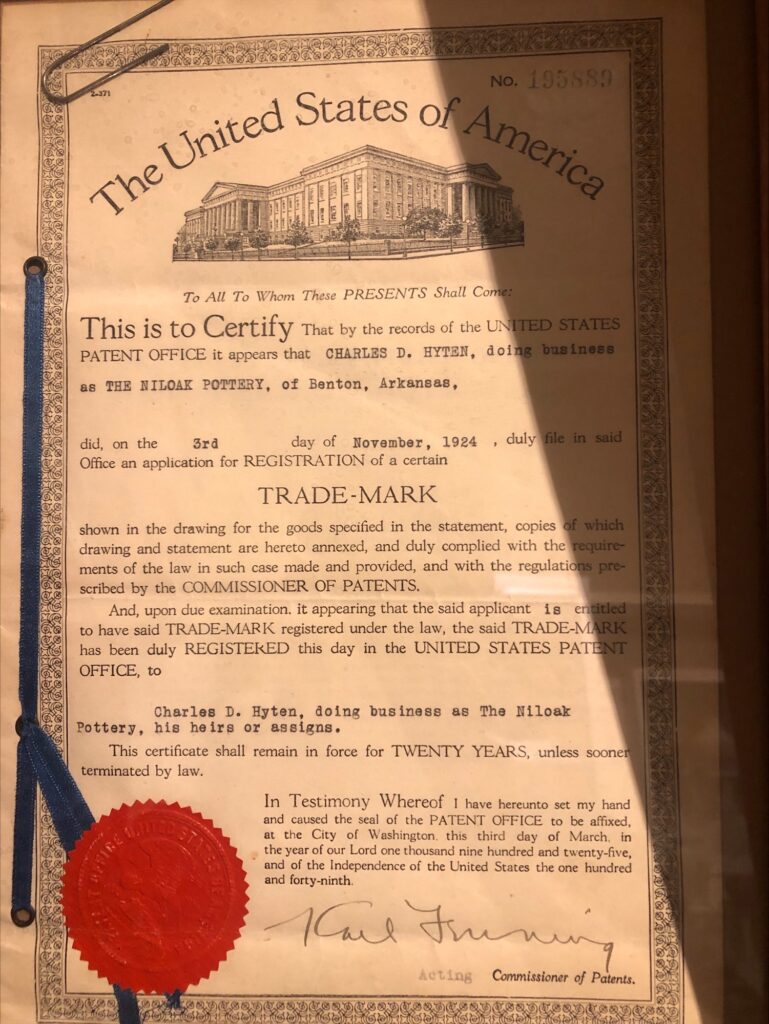Niloak Pottery’s Centennial Anniversary!
By Cody Berry
When we started going through the Gann Museum’s collections, we found an old box of items left behind by Arlene Hyten Rainey, the daughter of Niloak inventor Charles Hyten. The box contained her father’s bible, a sample of hair from a Civil War hero, Mr. Hyten’s formula books, and a patent certificate from the United States Patent Office. What the certificate reveals is that Charles Hyten was awarded the trademark on his world-famous pottery on November 3, 1924, meaning that November was the centennial anniversary of that event.1 I framed the paper and placed it in the Niloak Pottery exhibit next to a photograph of Mr. Hyten.

Pictured above: The patent for Niloak Pottery dated November 3rd, 1924, currently on display at the Gann Museum.
After doing some research on the Niloak Pottery here at the Gann Museum, I’ve learned quite a bit about the company from David Edwin Gifford’s book. In his Collector’s Encyclopedia of Niloak, from 2001, Mr. Gifford included another patent awarded to Mr. Hyten, this one was from January 31, 1928. That patent included information on how the famous swirled pottery got its brilliant colors. They used additives like cobalt for blue, ferric oxide for red and chromic oxide for grey.2
Kaolin, the clay Niloak was made from and named after is mostly white with some brown in it naturally. We have chunks of the stuff here at the Gann Museum. I even found one that was shaped like the State of Arkansas, so I put it in my display on the Saline County Courthouse. The 1924 patent certificate we found at the museum was for the trademark of the name “Nilaok Pottery” but not the process for making it. In the company’s early days, they used natural colors such as cream, browns, and greys. But, later on colors had to be added to achieve the same effect.3
The Niloak Pottery company was rumored to have made between 50,000 and 75,000 pieces annually but as Mr. Gifford pointed out in his book, “no records exist that can confirm or deny this statement.”4 While we know that Charles Hyten owned the company, he most certainly did not throw each piece. He employed several experienced potters like Frank Long, Reagan Rowland, Romine and Joshua McNeil, and Fred Johnson. All of them were working for Mr. Hyten as early as 1910.5
By 1915, Hyten’s Pearl Street plant was powered by gas. Mr. Gifford said that natural gas as a fuel was better than the traditional wood because it “einsured better temperature control and a more consistent color rendering.”6 The Niloak Pottery company had its best years in the 1920s before the Great Depression came and Mr. Hyten sold it to Hardy Winburn III in 1934. In 1947, the company dissolved, and the Winburn Tile Company was born. But it dissolved in 2001.7
So, the next time you come to the Gann Museum or see a piece of Niloak Pottery somewhere else, just think about the fact that it was made in Benton over 100 years ago.
Citations:
1 US Patent Office, Trademark Certificate Number 195889, granted to “Charles D. Hyten, doing business as The Niloak Pottery, of Benton, Arkansas, November 3, 1924.
2 David Edwin Gifford, Collector’s Encyclopedia of Niloak Reference and Values, Second Edition, Collector Books: Paducah, Kentucky, 2001, p. 33.
3 David Edwin Gifford, Collector’s Encyclopedia of Niloak Reference and Values, Second Edition, Collector Books: Paducah, Kentucky, 2001, p. 35.
4 David Edwin Gifford, Collector’s Encyclopedia of Niloak Reference and Values, Second Edition, Collector Books: Paducah, Kentucky, 2001, p. 39.
5 David Edwin Gifford, Collector’s Encyclopedia of Niloak Reference and Values, Second Edition, Collector Books: Paducah, Kentucky, 2001, p. 39.
6 David Edwin Gifford, Collector’s Encyclopedia of Niloak Reference and Values, Second Edition, Collector Books: Paducah, Kentucky, 2001, p. 38, 39.
7 Cindy Grisham, “Niloak Pottery,” CALS Encyclopedia of Arkansas, https://encyclopediaofarkansas.net/entries/niloak-pottery-586/, Date Accessed 11/27/2024.
